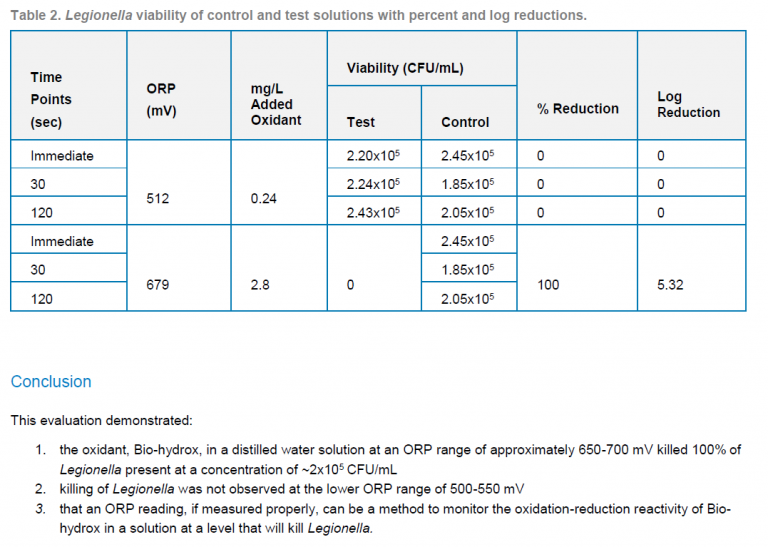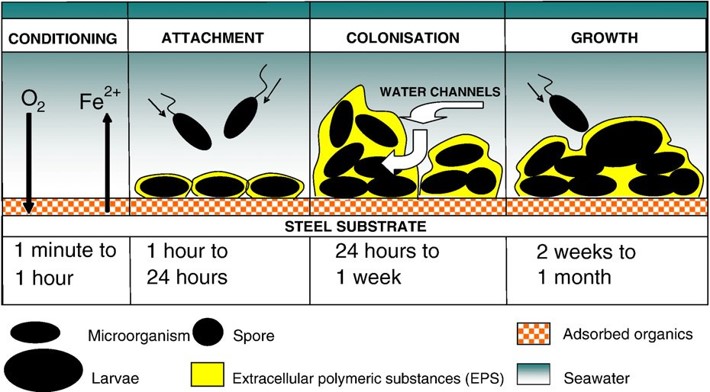Advanced oxidation processes eliminate pathogens by interfering with the redox balance in favor of oxidation. Their environment is overwhelmed and starved of electrons to a state not compatible with normal cellular function. There is no possibility of any pathogen building resistance to Bio-hydrox. Not known microorganism is able to survive oxidative stress. Advanced oxidation acts on the surface of the cell wall and does not need to cross that barrier. It destroys the seal by stealing electrons followed by lysis reactions and causing it to burst, and finally complete cell destruction.
Treatment of Legionella Bacteria
Bio-hydrox is a suitable treatment for eradication of Legionella colonies in water distribution systems and premise plumbing. It is effective against the bacteria in hot and cold water, even in dormant state or when protected by a host cell. Bio-hydrox penetrates and destroys biofilm and removes Legionella colonies.
Advanced oxidation is so fast reacting that Legionella bacteria does not have time to sense the chemical attack and look for refuge in a host cell. Because the disabling is a result of oxidative stress, a sub-atomic chemical reaction, it does not make a difference whether the bacteria is in dormant state. Water temperature favors Bio-hydrox. In hot water there is more electrochemical activity and the damage will be even faster. In cold water, there is less activity and the electrochemical potential is better apt to keep in a steady state and even to increase with lower temperature.
Third Party Verification Study
In September 2018, The Special Pathogen Laboratory, located in Pittsburg, PA, ran a time-kill assay to evaluate the effectivity of Bio-hydrox as a biocide against Legionella Pneumophila Serogroup 1. This evaluation demonstrated that at ORP ranges of approximately 650 – 750 mV, there was 100% immediate kill. See below:

Eliminating Legionella from a System
Below is an abstract from an article posted on LinkedIn:
Let’s consider the hypothetical scenario of decontaminating a building.
When using Bio-hydrox to remove Legionella bacteria from premise plumbing you will need to apply it at the point of entry, at a slightly higher concentration than would normally be present in drinking water and flush all the pipes. Run faucets and showers inside the building for a few minutes.
- This is not a burn or a traditional shock treatment. There is no need to apply an excessive concentration of the chemical. There will be no need to wash off the system.
- The building occupants do not need to be evacuated.
- It is 100% soluble in water.
- The operation will not generate toxic fumes.
- The pH of the water will not be affected and will not create a corrosive environment.
- It has been studied in Lab settings. The Special Pathogen Lab, in Pittsburgh, PA, conducted a time kill evaluation and found that Bio-hydrox killed all the Legionella bacteria in less than 5 seconds.
- There is no need to pressurize the system and allow for contact time.
- You will not need to replace plumbing or bathroom fixtures because the biofilm will be removed with the treatment.

How does our protocol for elimination of Legionella using Bio-hydrox compares to a typical protocol using Chlorine?
See below the recommendations from the Florida Department of Health:
Shock Chlorination: 1. Chlorine should be added to achieve a free chlorine residual of at least 2mg/L throughout the system. 2. This may require chlorination of the water heater or tank to levels of 20 to 50mg/L. 3. The pH of the water should be maintained between 7.0 to 8.0. 4. Each outlet should be flushed until the odor of chlorine is detected 5. The chlorine should remain in the system for a minimum of 2 hours (not to exceed 24 hrs) 6. Thoroughly flush the system.
Experience with this method of decontamination is limited, however, and high levels of free chlorine can corrode metals. Chlorine should be added, preferably overnight, to achieve a free chlorine residual of at least 2 mg/L (2 ppm) throughout the system.661 This may require chlorination of the water heater or tank to levels of 20–50 mg/L (20–50 ppm). The pH of the water should be maintained at 7.0–8.0
https://www.linkedin.com/pulse/legionella-whats-big-deal-emma-flanagan/
